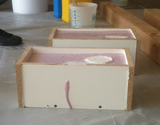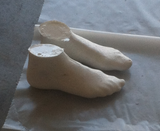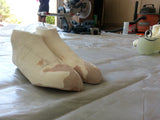 Last week, 11 volunteers in Cambridge and Worcester, Massachusetts tried on and climbed in the two pairs of suede prototypes SFT currently has. We would have loved to have more people give us feedback, but testing was limited to finding climbers who fit the two sizes we currently have.
Last week, 11 volunteers in Cambridge and Worcester, Massachusetts tried on and climbed in the two pairs of suede prototypes SFT currently has. We would have loved to have more people give us feedback, but testing was limited to finding climbers who fit the two sizes we currently have.
The feedback we received has been invaluable, both in terms of encouraging and inspiring us and in highlighting three major areas that need revision (as well as several smaller points that can be improved). What was most impressive was the general consistency in comments between many climbers. Multiple climbers, though separated by testing sessions and geography, said:
1. they would like to feel more support in the arch,
2. the shoe's asymmetry range was larger than necessary, and
3. one's toes can still flex more than desired in the aggressive position. Additionally, over half of the climbers stated that the shoes were very comfortable.
 The most common reaction, however, was to immediately explore the flexibility of the shoes. As Mak pointed out, we'd "never seen climbers wiggle their toes so much!" Some trip highlights: One climber exclaimed, "oh yeah, this is totally useful!" while finding the exact perfect adjustment for his shoes before beginning an overhanging problem. While at WPI, several climbers sat down and held an impromptu brainstorming session about what they'd like to see in the next set of prototypes. SFT is extraordinarily lucky that a lot of climbers are the improve-it-on-the-fly duct-tape-carrying types, so they've always got ideas to contribute.
The most common reaction, however, was to immediately explore the flexibility of the shoes. As Mak pointed out, we'd "never seen climbers wiggle their toes so much!" Some trip highlights: One climber exclaimed, "oh yeah, this is totally useful!" while finding the exact perfect adjustment for his shoes before beginning an overhanging problem. While at WPI, several climbers sat down and held an impromptu brainstorming session about what they'd like to see in the next set of prototypes. SFT is extraordinarily lucky that a lot of climbers are the improve-it-on-the-fly duct-tape-carrying types, so they've always got ideas to contribute.
 After some testing, adding friction back to the bearings in the system did not look promising. Instead, I machined a custom ladder lock (shown in silver in the image). This design has a third aperture for the webbing which eliminates the self-unlocking angle.
After some testing, adding friction back to the bearings in the system did not look promising. Instead, I machined a custom ladder lock (shown in silver in the image). This design has a third aperture for the webbing which eliminates the self-unlocking angle.


 With the new prototypes Ray helped us build, we've moved from proof-of-concept to design optimization and user feedback.
With the new prototypes Ray helped us build, we've moved from proof-of-concept to design optimization and user feedback.


 Cast a one-use material around your feet. Pour a hard plastic in the one-time mold.
Cast a one-use material around your feet. Pour a hard plastic in the one-time mold.  Remove the hard plastic cast. This is the basis of the custom last. Trim and adjust the last as needed. For example, I didn't do a perfect job of holding my feet in the same position, but Ray was able to adjust the left to match the right by skilled trimming and gluing. Mak and I tried to help out where an extra pair of hands was needed, but much of the artistry we just had to watch, document, and absorb.
Remove the hard plastic cast. This is the basis of the custom last. Trim and adjust the last as needed. For example, I didn't do a perfect job of holding my feet in the same position, but Ray was able to adjust the left to match the right by skilled trimming and gluing. Mak and I tried to help out where an extra pair of hands was needed, but much of the artistry we just had to watch, document, and absorb. Roughen the surface of the cast lasts and sculpt out the final shape of the shoe. For SFT, we wanted shoes that were more generic in shape that the ones Ray usually makes. This will let us share the first pairs of shoes made on these lasts with user testers who have similarly sized feet. This means that many of the peculiarities of our lasts were smoothed out so that the final shoes wouldn't be too customized for other people to wear.
Roughen the surface of the cast lasts and sculpt out the final shape of the shoe. For SFT, we wanted shoes that were more generic in shape that the ones Ray usually makes. This will let us share the first pairs of shoes made on these lasts with user testers who have similarly sized feet. This means that many of the peculiarities of our lasts were smoothed out so that the final shoes wouldn't be too customized for other people to wear. Ray showed us how to make quick masking tape patterns from our lasts to check sizing. He made up a couple of slippers that we tried on. They fit like gloves! Since the lasts passed this test, Ray will begin making two pairs of shoes in our design. We'll be working with him remotely for the next week as he builds them, and then he'll ship them to us for climb testing.
Ray showed us how to make quick masking tape patterns from our lasts to check sizing. He made up a couple of slippers that we tried on. They fit like gloves! Since the lasts passed this test, Ray will begin making two pairs of shoes in our design. We'll be working with him remotely for the next week as he builds them, and then he'll ship them to us for climb testing.